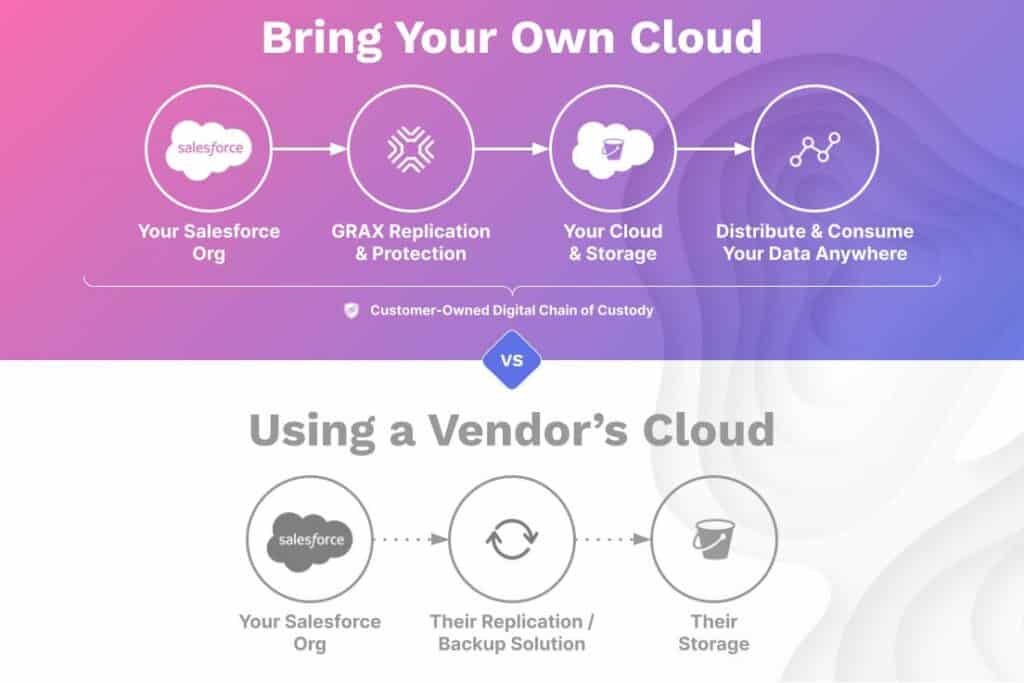The Essential Link Between Data Ownership and Data Activation

Everyone knows digital data is critical for competitive advantage. However, its value can only be realized if it’s secure, easy to access, and easily actionable. With so many businesses generating data that resides in Software as a Service (SaaS) solutions such as Salesforce and third-party backup products, that’s not always possible. Too often, companies struggle to be data-driven because they don’t really own their own data.
The convenience of having a third-party vendor own your backup data comes with risks. These include:
- increased costs
- greater exposure to data inaccuracies and cyber threats
- difficulties accessing and taking action on data
Data ownership mitigates these risks and empowers you to leverage data as a true strategic asset.
What is data ownership?
Ownership means you continually possess and are fully responsible for protecting your company’s data. It requires maintaining a Digital Chain of Custody. This includes monitoring each piece of information throughout every stage of replication and ensuring it is safeguarded at all times. You can’t do this if it’s not always in your possession.
Ownership is different from the “shared responsibility” model many SaaS vendors follow. With shared responsibility, vendors are responsible for keeping their application up and running – not for keeping your data protected or enabling it to be reused.
The best way to ensure data ownership is by keeping your own backup data in your own cloud environment – such as AWS, Microsoft Azure, or Google Cloud Platform – rather than in a vendor’s infrastructure.

Making your owned data actionable
Data ownership gives you the control needed to make your data actionable. When Salesforce data is actionable outside of the platform, you can use it to make better-informed decisions.
To be truly actionable, data must be relevant, accurate, complete, and accessible.
- Relevant
Relevant data relates directly to the question or decision at hand. It aligns with your business’s goals, challenges, or operational needs. - Accurate
Accurate data is correct, reliable, and error-free. By keeping it under your control in your own cloud, you can mitigate the risk of unauthorized access. You can also track all user behavior, including malicious changes and unintentional mistakes. - Complete
Missing data can skew analysis and lead to incorrect conclusions. By backing up and archiving historical data in your own environment, you ensure you have all the data you need to take action on. - Accessible
This means data is readily available whenever it’s needed. It’s also in a format that is easy to understand, simple to integrate with other data, and easy to reuse in other tools for other purposes – without complex extraction and transformation processes.
5 Ways to Distribute and Consume Owned, Actionable Salesforce Data
1. Advanced Reporting
Solutions like GRAX make data collection easy by enabling you to replicate Salesforce backup data into your own cloud. This lets you use advanced reporting tools that offer deeper, more customized insights on all your customer data than those available within Salesforce.
2. Integration into Data Warehouses / Data Lakes for Customer 360
Pipe the backed-up historical Salesforce data from your cloud into a data warehouse or data lake, and integrate it with other data assets such as Shopify, Amazon, and others. This is key to achieving Customer 360 – a holistic view of every interaction a customer has with your organization – from website inquiries to calls with sales reps, to product purchases and customer support tickets. It also facilitates complex analyses. You can use all versions of your data for mining and predictive modeling to uncover trends, patterns, and insights.
3. Training Artificial Intelligence and Machine Learning Models
AI and ML models require accurate and complete data. Data ownership makes it simple to reuse data for training high-quality AI and ML models that deliver reliable insights.
4. Simplifying Business Intelligence
GRAX stores all Salesforce-generated data in the Parquet format. This means you can use popular analysis tools – such as Tableau, Microsoft Azure Synapse Analytics, AWS QuickSight, or PowerBI – to gain actionable insights and improve customer experiences.
5. Enhancing Collaboration
Owning your data makes collaborating across teams and departments easier. With ready access to a unified data source; sales, data, and marketing teams can work together more effectively; share insights; and align strategies to achieve common goals.
GRAX: Your Partner in Salesforce Data Ownership
With GRAX, you can automatically backup and archive Salesforce data into your organization’s own AWS, Azure, Google Cloud, or even on-premises.
GRAX helps you ensure a Digital Chain Of Custody and data integrity. This maximizes the potential value of your data and helps your business maintain a competitive edge.
In the digital era, data is the currency of innovation. GRAX ensures you’re rich in what matters most.





